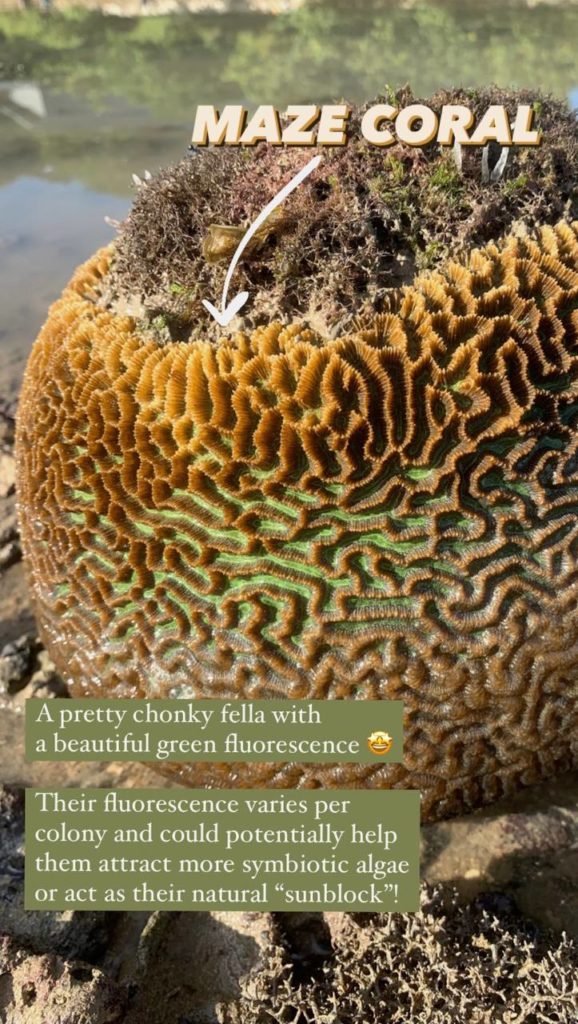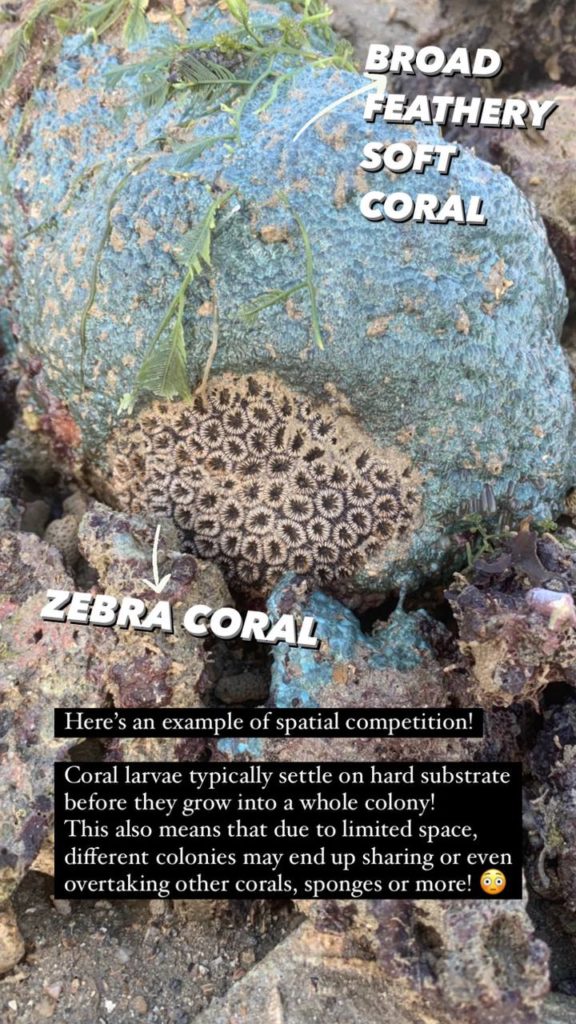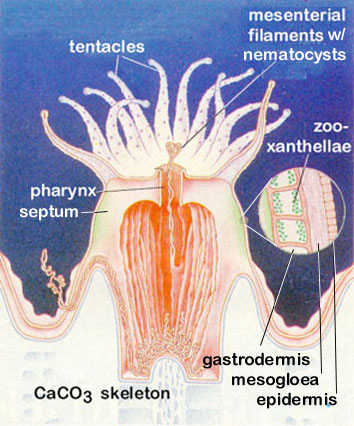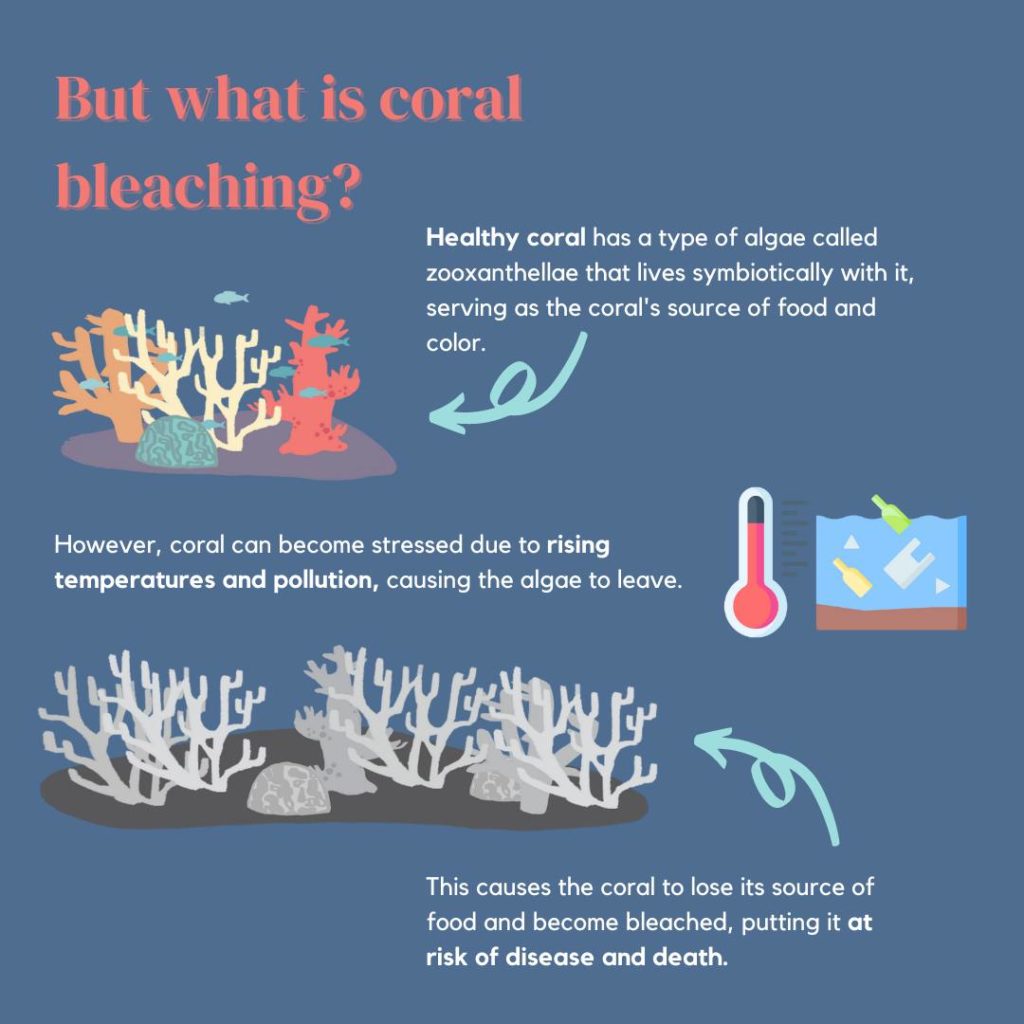_____________________________________________________________________________________________
Glossary
Invertebrates: Animals without a backbone. Examples of marine invertebrates aside from corals are squids, snails, crabs and worms.
Polyps: Tiny animals that collectively make up a coral.
Symbiotic relationship: An interaction between two organisms in which both organisms benefit from each other’s actions.
Symbiont: A member of a symbiotic relationship.
_____________________________________________________________________________________________
Many of us are probably already familiar with corals, having seen these beautiful organisms in documentaries or textbooks, and perhaps even being lucky enough to come face-to-face with these magnificent structures while diving or snorkelling in the ocean.
Corals can be found all over the world, with hundreds of coral species residing locally in Singapore’s waters1. Collectively, corals form a large ecosystem known as coral reefs, with the largest reef located at the Great Barrier Reef, Australia2. While these aesthetically appealing creations of nature may serve as gorgeous scenery to many, coral reefs are known to do much more than just that.
Did you know that although coral reefs constitute a mere 0.1% of the world’s oceanic area – about the size of Malaysia – they are responsible for sustaining the lives of approximately a quarter of all marine life?3
Take a moment to let that sink in – imagine how barren our oceans would be without them! Sad to say, these vital ecosystems are under great threat due to issues such as climate change and marine pollution. As such, the need to understand and protect these ecosystems has never been more imperative.
What Are Corals?
Before we delve into the details, it is important to clarify some misconceptions about corals.

Firstly, did you know that corals aren’t actually plants? Yes, you read that right – these immobile structures are animals, or more specifically, marine invertebrates that are in fact close relatives to sea anemones! (And yes again, anemones are not corals!)
Secondly, corals may often be conceived as beautiful and colourful structures in pristine, transparent waters with a plethora of marine organisms such as fishes inhabiting them4. However, corals may come in different species and colours (with some not as colourful as the rest), whereby not all of them may reside in clear and pristine waters5.

Alright, but what exactly are corals? Well, corals are a group of marine invertebrates classified under the phylum Cnidaria (a kind of grouping for all life forms), with each coral being a colony composed of thousands of polyps such as the one shown below in Figure 1.

Essentially, they are composed of two main tissue layers: the outer epidermis and the inner gastrodermis, with the mesoglea (a gelatinous layer) between the two layers. They are composed of a ‘mouth’ that leads to a pharynx which eventually leads to a ‘stomach’. It does not have an anus.
The reason why ‘mouth’ and ‘stomach’ are in inverted commas is that corals (and other animals in the Phylum Cnidaria) do not possess any organs and instead are composed of tissues. Their ‘mouths’ are also armed with tentacles that possess stinging cells (nematocysts).6
Corals are generally classified into two categories – hard or soft corals. The terms ‘hard coral’ and ‘soft coral’ are actually literal in meaning – ‘hard coral’ is rigid to touch while ‘soft coral’ is soft. Interesting, isn’t it? But what exactly accounts for the difference?
It is none other than the presence of calcium carbonate! Hard corals secrete a calcium carbonate skeleton that gives it its ‘hardness’, while soft corals do not. For this reason, hard corals are known to play a major role in reef-building and are what constitute coral reefs7.
How Do They Feed?
Given that corals are animals, they are unable to make their own food. As such some corals display a symbiotic relationship with a type of photosynthetic algae known as zooxanthellae. These corals allow the algae to live within their tissues, providing them with shelter and minerals, while in exchange the algae produce food via photosynthesis and shares the food with the corals.
Other corals make use of their tentacles armed with stinging cells, where they extend these tentacles into the water to capture small-sized prey such as plankton or small fish and transport them into the coral polyp’s “mouth”. Figure 2 below shows how these stinging cells work in sequence (from left to right) – they are essentially like harpoon guns that shoot out to stun or kill their prey!8
Importance Of Coral Reefs And The Threats They Face
Coral reefs are extremely important to the world as they provide us with an array of ecosystem services.
Ecosystem services can be defined simply as “any positive benefit that wildlife or ecosystems provide to people”9. One of these benefits includes providing us with the seafood we consume. Coral reefs provide shelter and habitats for many marine organisms such as fishes, thus providing us with fisheries where we are able to harvest seafood from.
Coral reefs are also an important coastal defence, being known to shelter coasts from erosion through reducing wave energy (the waves hit the coasts more gently!) by more than 90%10. Aside from that, they are also important for tourism as their alluring beauty attracts people worldwide, with many countries offering snorkelling or diving activities at their local reefs. If we were to monetise and add up the ecosystem services provided by coral reefs, it is estimated that coral reefs are valued at more than S$220 billion a year!
Sadly, like many other ecosystems in the world, coral reefs are under great threat. One of the greatest threats it faces is climate change, whereby warming of the ocean’s water brings about unfavourable conditions for its algal symbiont (zooxanthellae), causing it to be expelled from the coral’s tissue. This results in the coral being bleached, causing it to lose its colour, becoming more vulnerable and likely to die.

Ocean acidification is also another problem, as acidic waters would react with calcium carbonate – an essential mineral used to build the skeleton of hard corals – thus reducing its availability in the ocean. Overfishing of certain fish species such as parrotfish also poses a danger to coral reefs. Parrotfish spend 90% of their day eating algae off coral reefs that cleans them and keeps them healthy11.

Destructive fishing practices such as trawling (pulling a huge net across the seabed) decimate coral reefs by dislodging and scraping all marine life present on the seabed, thus killing off reefs. In Singapore, sedimentation due to our extensive land reclamation activities poses the biggest threat to our coral reefs by limiting coral growth12, as sedimentation reduces light availability, an important resource for the zooxanthellae to photosynthesise.
What We Can Do
With regard to issues such as climate change, each individual’s action might seem like a drop in the ocean. However, collectively, they can be extremely powerful.
The first step in making a difference is raising people’s awareness of these issues, which can be done by sharing the information that you have learnt with friends and family members. Other important actions we can take include the 3Rs – reduce, reuse, recycle, with reduce being the most important.
Reducing our energy use, waste and consumption purchase are gradual but steady changes we can make in our lifestyle to cut our carbon footprints. We can also switch to more energy-efficient products, for example, LED light bulbs instead of normal ones.
Participating in community projects such as beach cleanups are also wonderful opportunities to meet people and contribute to the environment.
You can also fund coral restoration projects, and use reef-safe sunblock that doesn’t contain oxybenzone and octinoxate that decreases the corals’ defense against bleaching13.
Lastly, I hope that after reading, you have grown to have a deeper appreciation for our ocean!




2 thoughts on “All About Corals”
Hello, i noticed in your instagram highlights that you have uploaded pictures/videos of you going off-trail. I really appreciate Earth School’s effort to promote sustainability and wildlife conservation. But going off trail has many detrimental effects such as soil compaction and erosion which can cause reduced water infiltration and reduced plant growth. Not only that, tree saplings, small plants and animals may get trampled in the process. Plus the act of posting it on social media might spur others to go off-trail too. This is not only harmful to the wildlife but also unsafe for humans too if they are not familiar with the area. I do hope that you will take my feedback in mind 🙂
Hi Shin Yin (if I may), thank you for dropping us a message and for your concern! I’d like to assure you that we fully understand these implications to the ecosystem when we engage in these activities. As Environmental Studies and Life Science undergraduates, some of these pictures you see are often part of research projects or if so, out of interest, we do the best in our practice to leave no harm behind. I understand that there are inherent stressors in doing so and we’d like to assure you that we don’t do these trips very often, and we are actually glad that some of these intertidal areas are under gatekeeping by authorities now (we’re also glad that we have such involved individuals too!).
If you’ve followed our Instagram stories for some time as well, you’d have seen that we’ve always put up a message for interested members of the public to engage an experienced guide such as those from Young Nautilus to bring them on these nature trails – for their own protection and for the ecosystem. We’d be happy to provide you receipts of these messages as well. In addition, we’ll be removing the location tag from all our highlights and future stories to avoid people adventuring there on their own. I hope this assures you a little better.
Do reach out to us at hello@earthschool.sg if you’d have any other areas of concern or any suggestions on how we can improve our fieldwork. Stay well and keep green! – Earth School Singapore team